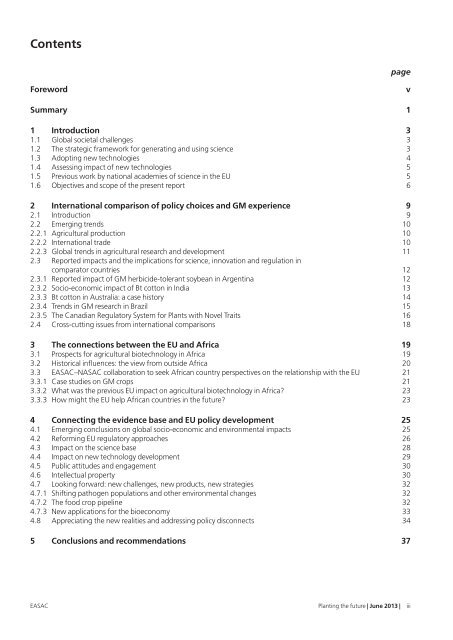Planting the future: opportunities and challenges for using ... - EASAC
Planting the future: opportunities and challenges for using ... - EASAC
Planting the future: opportunities and challenges for using ... - EASAC
You also want an ePaper? Increase the reach of your titles
YUMPU automatically turns print PDFs into web optimized ePapers that Google loves.
Contents<br />
page<br />
Forewordv<br />
Summary1<br />
1 Introduction 3<br />
1.1 Global societal <strong>challenges</strong> 3<br />
1.2 The strategic framework <strong>for</strong> generating <strong>and</strong> <strong>using</strong> science 3<br />
1.3 Adopting new technologies 4<br />
1.4 Assessing impact of new technologies 5<br />
1.5 Previous work by national academies of science in <strong>the</strong> EU 5<br />
1.6 Objectives <strong>and</strong> scope of <strong>the</strong> present report 6<br />
2 International comparison of policy choices <strong>and</strong> GM experience 9<br />
2.1 Introduction 9<br />
2.2 Emerging trends 10<br />
2.2.1 Agricultural production 10<br />
2.2.2 International trade 10<br />
2.2.3 Global trends in agricultural research <strong>and</strong> development 11<br />
2.3 Reported impacts <strong>and</strong> <strong>the</strong> implications <strong>for</strong> science, innovation <strong>and</strong> regulation in<br />
comparator countries 12<br />
2.3.1 Reported impact of GM herbicide-tolerant soybean in Argentina 12<br />
2.3.2 Socio-economic impact of Bt cotton in India 13<br />
2.3.3 Bt cotton in Australia: a case history 14<br />
2.3.4 Trends in GM research in Brazil 15<br />
2.3.5 The Canadian Regulatory System <strong>for</strong> Plants with Novel Traits 16<br />
2.4 Cross-cutting issues from international comparisons 18<br />
3 The connections between <strong>the</strong> EU <strong>and</strong> Africa 19<br />
3.1 Prospects <strong>for</strong> agricultural biotechnology in Africa 19<br />
3.2 Historical influences: <strong>the</strong> view from outside Africa 20<br />
3.3 <strong>EASAC</strong>–NASAC collaboration to seek African country perspectives on <strong>the</strong> relationship with <strong>the</strong> EU 21<br />
3.3.1 Case studies on GM crops 21<br />
3.3.2 What was <strong>the</strong> previous EU impact on agricultural biotechnology in Africa? 23<br />
3.3.3 How might <strong>the</strong> EU help African countries in <strong>the</strong> <strong>future</strong>? 23<br />
4 Connecting <strong>the</strong> evidence base <strong>and</strong> EU policy development 25<br />
4.1 Emerging conclusions on global socio-economic <strong>and</strong> environmental impacts 25<br />
4.2 Re<strong>for</strong>ming EU regulatory approaches 26<br />
4.3 Impact on <strong>the</strong> science base 28<br />
4.4 Impact on new technology development 29<br />
4.5 Public attitudes <strong>and</strong> engagement 30<br />
4.6 Intellectual property 30<br />
4.7 Looking <strong>for</strong>ward: new <strong>challenges</strong>, new products, new strategies 32<br />
4.7.1 Shifting pathogen populations <strong>and</strong> o<strong>the</strong>r environmental changes 32<br />
4.7.2 The food crop pipeline 32<br />
4.7.3 New applications <strong>for</strong> <strong>the</strong> bioeconomy 33<br />
4.8 Appreciating <strong>the</strong> new realities <strong>and</strong> addressing policy disconnects 34<br />
5 Conclusions <strong>and</strong> recommendations 37<br />
<strong>EASAC</strong><br />
<strong>Planting</strong> <strong>the</strong> <strong>future</strong> | June 2013 | iii


